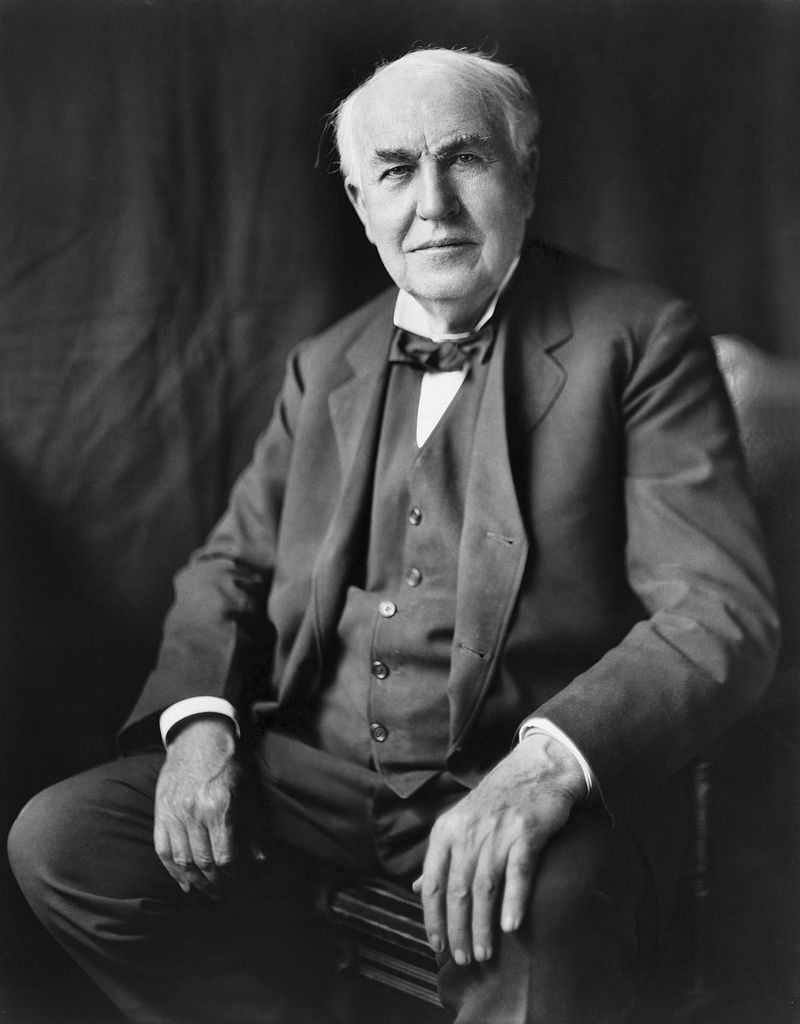Unleashing Brilliance: Leadership Lessons from Thomas Edison’s Innovation Legacy

Igniting Leadership Sparks: Exploring the Remarkable Lessons of Thomas Edison
Thomas Edison’s legacy as an innovative leader
Thomas Edison, widely regarded as one of the greatest inventors in history, left an indelible mark on the world through his groundbreaking inventions and entrepreneurial spirit. From the invention of the phonograph and the practical electric light bulb to numerous advancements in telegraphy and motion pictures, Edison’s contributions revolutionized several industries and shaped the modern world. Beyond his technical genius, Edison’s leadership prowess played a pivotal role in his success.
Brief overview of Thomas Edison’s life and accomplishments
Born in 1847 in Milan, Ohio, Thomas Edison exhibited a curiosity and an insatiable thirst for knowledge from an early age. Although he had limited formal education, his innate drive and passion for innovation propelled him forward. Throughout his illustrious career, Edison accumulated over 1,000 patents and founded the world-renowned Edison General Electric Company (now General Electric), leaving an unparalleled legacy.
Thomas Edison’s leadership lessons and stories offer valuable insights for modern leaders
Beyond his technical brilliance, Edison’s leadership approach and mindset were instrumental in his ability to create and lead high-performing teams, navigate challenges, and foster a culture of innovation. In this article, we will delve into the captivating leadership lessons and stories of Thomas Edison, exploring the principles and practices that enabled him to become an iconic leader. By drawing inspiration from his experiences, modern leaders can glean valuable insights to enhance their own leadership journeys.
The Power of Perseverance
Edison’s early struggles and setbacks
Thomas Edison’s early career was marked by numerous struggles and setbacks that could have easily discouraged a less determined individual. As a young inventor and entrepreneur, he faced financial challenges, experienced multiple business failures, and encountered numerous obstacles along the way. However, it was through these hardships that Edison developed his unwavering resilience and a remarkable ability to persevere in the face of adversity.
Despite his difficulties, Edison remained undeterred. He recognized that each setback provided an opportunity for growth and learning. Instead of viewing failure as a final outcome, he saw it as a stepping stone on the path to success. Edison once famously said, “I have not failed. I’ve just found 10,000 ways that won’t work.” This perspective demonstrates his tenacity and refusal to be discouraged by temporary setbacks.
Lessons on embracing failure and learning from it
Edison’s approach to failure holds valuable lessons for leaders in any field. Firstly, he understood that failure is an inherent part of the journey towards innovation and progress. In a world where success is often celebrated and failure stigmatized, Edison’s mindset provides a refreshing perspective. He viewed failures as essential learning experiences that bring him one step closer to success.
Leaders can learn from Edison’s ability to embrace failure by encouraging a culture of experimentation and risk-taking within their organizations. By normalizing the idea that failures are learning opportunities, leaders create an environment where their teams feel empowered to explore new ideas, take calculated risks, and push boundaries. This fosters a culture of innovation and creativity, where mistakes are seen as stepping stones towards improvement.
Moreover, Edison’s relentless pursuit of solutions serves as a reminder that perseverance is essential for overcoming obstacles. He refused to give up, even when faced with repeated failures. This determination allowed him to continue iterating, experimenting, and refining his ideas until he achieved the desired outcome. Leaders can adopt this mindset by encouraging their teams to persist in the face of challenges and setbacks. By demonstrating resilience and unwavering commitment, leaders inspire their teams to stay focused on long-term goals and maintain a positive outlook.
How Edison’s perseverance fueled his success
Edison’s unwavering perseverance played a pivotal role in his numerous groundbreaking inventions. His tireless dedication to finding solutions and his refusal to accept defeat propelled him forward. For instance, in his quest to create a practical electric light bulb, Edison tirelessly experimented with different materials and designs, facing failure after failure. Despite the immense challenges, he continued to innovate, test, and refine his ideas until he finally achieved success.
Edison’s perseverance also extended to his team. He carefully selected individuals who shared his passion for innovation and provided them with the necessary resources and support to explore new ideas. This collaborative approach allowed him to tap into the collective knowledge and expertise of his team members, ultimately leading to breakthrough innovations.
Leaders can draw inspiration from Edison’s perseverance by remaining committed to their vision, even when faced with setbacks and obstacles. By demonstrating unwavering determination and resilience, leaders inspire their teams to persevere through challenges and find creative solutions. Edison’s example reminds us that success often requires persistence, adaptability, and an unyielding belief in one’s abilities.
Thomas Edison’s remarkable ability to persevere in the face of adversity serves as a powerful lesson for leaders. His unwavering commitment to learning from failure, embracing setbacks as opportunities for growth, and his determination to overcome obstacles are key principles that modern leaders can incorporate into their own leadership journeys. By adopting Edison’s mindset of perseverance, leaders can create a culture of resilience, innovation, and continuous improvement within their organizations, ultimately driving long-term success.
Visionary Thinking and Innovation
Edison’s ability to envision the future
One of the defining qualities of Thomas Edison’s leadership was his visionary thinking. He possessed a unique ability to imagine possibilities beyond the constraints of the present. Edison envisioned a world powered by electricity, with advancements in communication and entertainment that were previously unimaginable. His ability to see the potential for innovation and progress set him apart as a leader.
Edison’s visionary mindset was fueled by a deep understanding of market needs and a keen awareness of technological advancements. He constantly sought opportunities to apply his creativity and scientific knowledge to solve real-world problems. By anticipating future trends and consumer demands, Edison was able to stay ahead of his time and drive transformative change.
Lessons on cultivating a forward-thinking mindset
Leaders can learn from Edison’s approach to visionary thinking by cultivating a forward-thinking mindset within themselves and their teams. This involves actively seeking new insights, staying abreast of industry trends, and envisioning the future landscape of their respective fields. By fostering a culture of curiosity and continuous learning, leaders can encourage their teams to think beyond the status quo and challenge conventional wisdom.
Additionally, leaders can cultivate visionary thinking by fostering diverse perspectives and interdisciplinary collaboration. Edison surrounded himself with a team of talented individuals from various backgrounds, each bringing unique insights and expertise. By encouraging diverse viewpoints and creating platforms for interdisciplinary collaboration, leaders can unlock innovative solutions and approaches that may have otherwise gone unnoticed.
The importance of innovation in leadership
Edison’s legacy as an innovative leader serves as a testament to the critical role of innovation in leadership. He constantly pushed the boundaries of what was possible, challenging conventional wisdom and finding new ways to solve problems. This commitment to innovation not only led to groundbreaking inventions but also transformed entire industries.
Leaders today face a rapidly changing and increasingly complex business landscape. To thrive in this environment, they must embrace innovation as a core leadership principle. This involves fostering a culture of creativity, experimentation, and risk-taking. Leaders should create an environment where ideas are welcomed, failures are seen as learning opportunities, and employees are encouraged to explore new possibilities.
Moreover, innovation in leadership extends beyond product or technological advancements. It also encompasses innovative approaches to team management, process improvement, and customer experience. Leaders should continuously seek ways to improve existing systems, streamline operations, and enhance the overall value proposition for their customers.
By embracing innovation and visionary thinking, leaders can drive organizational growth, stay relevant in the face of disruption, and inspire their teams to reach new heights of creativity and performance.
Thomas Edison’s visionary thinking and commitment to innovation offer valuable lessons for leaders. By cultivating a forward-thinking mindset, embracing diverse perspectives, and fostering a culture of innovation, leaders can propel their organizations forward in an ever-evolving world. Edison’s legacy reminds us that the ability to anticipate and shape the future is a key trait of successful leaders, and it is through visionary thinking that leaders can unlock new possibilities and drive meaningful change.
Embracing Failure as a Learning Opportunity
Edison’s philosophy on failure
Thomas Edison had a unique perspective on failure that set him apart as a leader. He believed that failure was not something to be feared or avoided but rather a necessary part of the path to success. Edison famously remarked, “I have not failed. I’ve just found 10,000 ways that won’t work.” This mindset demonstrates his understanding that failure is a valuable source of knowledge and a stepping stone towards eventual success.
Lessons on reframing failure as a stepping stone to success
Edison’s approach to failure provides essential lessons for leaders in today’s world. Firstly, he recognized that failure is an inherent part of the innovation process. In his countless experiments and attempts to invent the practical electric light bulb, he encountered numerous failures. Yet, he never allowed these setbacks to discourage him or dampen his spirit of innovation. Instead, he saw each failure as an opportunity to learn, adjust, and improve his approach.
Leaders can learn from Edison’s perspective by embracing failure as a necessary part of the learning journey. By shifting the narrative around failure, leaders can create an environment where taking risks and learning from mistakes is encouraged. Edison’s mindset reminds us that failure should not be viewed as a final outcome or a reflection of one’s abilities but rather as a valuable feedback mechanism that informs future actions.
Creating a culture that encourages risk-taking and learning from failures
Edison’s leadership style was characterized by creating a culture that embraced risk-taking and learning from failures. He cultivated an environment where his team members felt empowered to experiment, explore new ideas, and push boundaries. This culture of innovation and continuous learning allowed Edison and his team to make significant breakthroughs and achieve remarkable success.
Leaders can foster a similar culture within their organizations by encouraging calculated risk-taking and creating psychological safety. When employees feel supported in taking risks and know that failures will be met with understanding and an opportunity for growth, they are more likely to step out of their comfort zones and think creatively. Leaders should create channels for open and honest communication, where failures are shared, discussed, and transformed into valuable learning experiences.
Additionally, leaders should lead by example and demonstrate vulnerability in their own approach to failure. When leaders share their own stories of setbacks and failures, they normalize the experience and create a safe space for others to do the same. This transparency fosters a culture of trust, collaboration, and continuous improvement.
By embracing failure as a learning opportunity, leaders can create an environment that encourages innovation, resilience, and personal growth. Edison’s philosophy teaches us that failures are not the end but rather crucial stepping stones on the path to success. Leaders who embrace this mindset and cultivate a culture of learning from failures will empower their teams to take risks, think creatively, and ultimately drive the organization forward.
Thomas Edison’s perspective on failure as a learning opportunity provides valuable lessons for leaders. By reframing failure, creating a culture that encourages risk-taking, and fostering an environment of continuous learning, leaders can harness the power of failure to drive innovation and growth within their organizations. Edison’s legacy reminds us that failures should be celebrated as milestones of progress and serve as valuable lessons that pave the way for future success.
Team Building and Collaboration
Edison’s approach to building a talented team
Thomas Edison recognized that building a talented and cohesive team was essential for driving innovation and achieving his ambitious goals. He carefully handpicked individuals who possessed diverse skills, expertise, and a shared passion for making a difference. Edison understood that assembling a team of exceptional individuals would amplify his own capabilities and bring a multitude of perspectives to the table.
Lessons on fostering collaboration and leveraging diverse perspectives
Edison’s approach to team building offers valuable insights for modern leaders. Firstly, he emphasized the importance of diversity within his team. By bringing together individuals from different backgrounds, with varied experiences and expertise, he created a rich tapestry of perspectives. This diversity of thought sparked vibrant discussions, challenged assumptions, and ultimately led to more robust and innovative solutions.
Leaders can learn from Edison’s approach by actively seeking diversity within their teams. By embracing differences in gender, ethnicity, age, background, and skill sets, leaders can tap into a wealth of perspectives and ideas. This diversity not only enhances problem-solving but also fosters an inclusive and welcoming environment where all team members feel valued and heard.
Additionally, Edison believed in the power of collaboration. He created an atmosphere of open communication and teamwork, where ideas were freely shared and debated. He recognized that great ideas could emerge from anyone within the team, regardless of their position or level of expertise. Edison’s willingness to listen and consider the input of others enabled him to leverage the collective intelligence of his team.
Leaders can foster collaboration by creating platforms for open dialogue and idea-sharing. Encouraging regular team meetings, brainstorming sessions, and cross-functional projects can facilitate collaboration and synergy. By fostering a culture that values and rewards collaboration, leaders empower their teams to work together towards common goals, resulting in increased creativity, efficiency, and overall team performance.
Strategies for effective team management and motivation
Edison’s approach to team building extended beyond assembling a talented and diverse group of individuals. He also implemented strategies to effectively manage and motivate his team members. Edison understood the importance of providing his team with the necessary resources, autonomy, and support to excel in their roles.
Leaders can adopt Edison’s strategies by empowering their team members and delegating responsibilities. By providing clear expectations and goals, while allowing autonomy and decision-making authority, leaders create a sense of ownership and accountability within the team. This fosters a culture of trust and empowers individuals to take initiative, innovate, and contribute to the organization’s success.
Furthermore, Edison recognized the significance of recognizing and celebrating achievements. He acknowledged the efforts and contributions of his team members, which not only boosted morale but also reinforced a culture of appreciation and recognition. Leaders should regularly acknowledge and reward outstanding performance, fostering a positive and motivated work environment.
Thomas Edison’s approach to team building and collaboration serves as a valuable guide for leaders. By embracing diversity, fostering collaboration, and implementing effective team management strategies, leaders can unlock the full potential of their teams. Edison’s legacy reminds us that by assembling a talented and diverse group of individuals, providing the necessary support and autonomy, and fostering a culture of collaboration and appreciation, leaders can create high-performing teams that drive innovation and achieve remarkable results.
Leading by Example
Edison’s hands-on leadership style
Thomas Edison was not just a visionary inventor, but also a hands-on leader who led by example. He actively engaged in the work and experimentation alongside his team members, immersing himself in the details of the projects. Edison’s hands-on approach demonstrated his commitment, dedication, and passion for his work, inspiring those around him to give their best.
Lessons on leading through action and setting high standards
Edison’s leadership style offers important lessons for modern leaders. Firstly, he understood the power of leading through action. By actively participating in the work, Edison showed his team that he was not just a figurehead, but someone who was willing to get their hands dirty and put in the effort. This level of involvement created a sense of shared purpose and instilled confidence in the team.
Leaders can emulate Edison’s approach by actively engaging in the work alongside their team members. By demonstrating a strong work ethic, attention to detail, and a commitment to excellence, leaders inspire their teams to strive for greatness. Setting high standards through personal example motivates and challenges team members to exceed expectations and deliver their best work.
Additionally, Edison believed in the importance of continuous improvement. He constantly sought ways to optimize processes, enhance efficiency, and refine his inventions. This pursuit of excellence was evident in his relentless testing and iterating. Edison’s relentless pursuit of improvement set the bar high for his team, inspiring them to constantly push boundaries and challenge the status quo.
Leaders can foster a culture of continuous improvement by encouraging their teams to seek better solutions, embrace innovation, and embrace a growth mindset. By creating an environment where feedback is welcomed, mistakes are viewed as learning opportunities, and continuous learning is valued, leaders enable their teams to reach new heights of performance and innovation.
Inspiring others through personal commitment and work ethic
One of the most inspiring aspects of Edison’s leadership was his personal commitment and work ethic. He was known for his long hours of dedicated work, often sleeping in his laboratory and relentlessly pursuing his goals. Edison’s unwavering commitment to his work and his vision inspired his team members to match his level of dedication and passion.
Leaders can inspire their teams by demonstrating a similar level of commitment and work ethic. By showing up consistently, investing time and effort into their work, and remaining dedicated to their vision, leaders set a powerful example for their teams to follow. Edison’s legacy reminds us that leadership is not just about giving instructions from the sidelines but about actively engaging and immersing oneself in the work.
Thomas Edison’s hands-on leadership style and commitment to excellence provide valuable lessons for leaders. By leading through action, setting high standards, and inspiring others through personal commitment and work ethic, leaders can foster a culture of excellence, passion, and continuous improvement. Edison’s example serves as a reminder that true leadership goes beyond words and demands active participation, setting the stage for inspired and high-performing teams.
Adaptability and Flexibility
Edison’s ability to adapt to changing circumstances
Thomas Edison’s leadership was characterized by his remarkable ability to adapt to changing circumstances. Throughout his career, he faced numerous technological advancements, shifting market demands, and evolving industry landscapes. However, Edison consistently demonstrated a willingness to embrace change and adapt his strategies to meet new challenges head-on.
Edison understood that staying stagnant in the face of change was a recipe for obsolescence. He actively sought to understand emerging technologies and market trends, allowing him to pivot and adjust his approach accordingly. Whether it was transitioning from telegraphy to electric lighting or embracing new developments in motion pictures, Edison’s adaptability enabled him to remain at the forefront of innovation.
Lessons on staying agile in a rapidly evolving world
In today’s fast-paced and dynamic business environment, leaders must be able to navigate constant change and uncertainty. Edison’s ability to adapt provides valuable lessons for leaders striving to stay relevant and drive success. Firstly, leaders must cultivate a mindset of agility and flexibility. This involves staying attuned to market trends, technological advancements, and customer needs. By proactively seeking opportunities and anticipating potential disruptions, leaders can position themselves and their organizations for success.
Additionally, leaders should foster a culture of learning and continuous improvement within their teams. By encouraging a growth mindset and embracing change as an opportunity for growth, leaders create an environment where adaptability becomes second nature. This includes providing learning and development opportunities, encouraging experimentation, and promoting knowledge-sharing.
Strategies for leading through uncertainty and managing change
Edison’s approach to adaptability offers strategies for leading through uncertainty and managing change effectively. Firstly, leaders should communicate openly and transparently with their teams during times of change. This includes providing clarity on the reasons for change, the desired outcomes, and the role of each team member in the process. Clear and consistent communication helps alleviate fears and build trust, enabling the team to navigate change more effectively.
Moreover, leaders should encourage collaboration and empower their teams to contribute to the change process. Edison understood the importance of leveraging the collective intelligence of his team members. By involving them in decision-making, seeking their input, and valuing their perspectives, leaders can tap into their creativity and problem-solving abilities.
Finally, leaders should be willing to adjust strategies and pivot when necessary. Edison’s willingness to let go of failed experiments and pivot towards new opportunities demonstrates the importance of agility and adaptability. Leaders should encourage experimentation, monitor progress closely, and be ready to make course corrections when needed.
Thomas Edison’s adaptability and flexibility provide crucial lessons for leaders in today’s rapidly changing world. By embracing change, fostering agility, and creating a culture of learning and collaboration, leaders can position their organizations for success. Edison’s legacy reminds us that adaptability is not only a survival skill but also a key driver of innovation and long-term success.
Building a Culture of Innovation
Edison’s approach to creating an innovative culture at his laboratories
Thomas Edison recognized that fostering a culture of innovation was paramount to driving continuous progress and achieving groundbreaking discoveries. He established research laboratories where brilliant minds could collaborate, experiment, and push the boundaries of knowledge. These laboratories became hubs of creativity and innovation, setting the stage for numerous groundbreaking inventions.
Edison’s approach to building a culture of innovation involved creating an environment that encouraged curiosity, experimentation, and risk-taking. He provided his team members with the necessary resources, freedom, and support to explore new ideas and pursue their innovative endeavors. By nurturing a culture that embraced new possibilities and encouraged thinking outside the box, Edison unlocked the creative potential of his team.
Lessons on fostering a culture of creativity, experimentation, and continuous learning
The lessons from Edison’s approach to building an innovative culture are highly relevant in today’s rapidly evolving business landscape. Leaders can learn from Edison’s example by cultivating an environment that values and rewards creativity, experimentation, and continuous learning.
Firstly, leaders should foster a culture of psychological safety where individuals feel comfortable expressing their ideas and taking calculated risks. This involves creating an environment free from fear of failure, where mistakes are seen as opportunities for growth and learning. When employees feel safe to explore new ideas and experiment, they are more likely to unleash their creative potential and contribute innovative solutions.
Secondly, leaders should provide the necessary resources, both financial and intellectual, to support innovative initiatives. Edison recognized the importance of investing in research and development, providing his team with the tools and materials they needed to bring their ideas to life. Leaders should allocate resources for innovation, create dedicated spaces for experimentation, and encourage cross-functional collaboration.
Additionally, leaders should prioritize continuous learning within their organizations. This can be achieved by providing opportunities for professional development, training programs, and knowledge-sharing platforms. By promoting a growth mindset and valuing ongoing learning, leaders empower their teams to stay ahead of industry trends, acquire new skills, and embrace emerging technologies.
Encouraging an entrepreneurial mindset within the organization
Another aspect of Edison’s innovative culture was fostering an entrepreneurial mindset within his organization. Edison encouraged his team members to think like entrepreneurs, taking ownership of their ideas and pursuing them with determination. He created an atmosphere where calculated risk-taking and seizing opportunities were celebrated.
Leaders can encourage an entrepreneurial mindset by empowering individuals to take initiative and explore new avenues. This involves creating avenues for intrapreneurship, where employees can develop and test their innovative ideas within the organization. By providing autonomy, resources, and recognition for entrepreneurial efforts, leaders inspire their teams to become catalysts for change and drive innovation from within.
Thomas Edison’s approach to building a culture of innovation provides valuable insights for leaders seeking to foster creativity, experimentation, and continuous learning within their organizations. By creating an environment that values and rewards innovation, encouraging risk-taking, and fostering an entrepreneurial mindset, leaders can unlock the full potential of their teams and drive remarkable breakthroughs. Edison’s legacy reminds us that innovation is not just about individual genius, but also about creating the conditions that nurture and amplify collective creativity.
The Importance of Continuous Learning
Edison’s dedication to self-improvement and lifelong learning
Thomas Edison was not only an innovative leader but also a lifelong learner. Despite his tremendous achievements, he never rested on his laurels. Edison had an insatiable thirst for knowledge and was constantly seeking ways to improve himself and expand his understanding of the world. His commitment to continuous learning played a crucial role in his ability to stay at the forefront of innovation.
Edison recognized that the world was constantly evolving, and to remain relevant, he needed to keep pace with the latest advancements. He voraciously read books, scientific journals, and technical literature, and actively engaged in conversations with experts from various fields. This dedication to self-improvement allowed him to acquire a broad knowledge base and continually refine his ideas and inventions.
Lessons on embracing a growth mindset and fostering a learning culture
Edison’s dedication to continuous learning offers valuable lessons for leaders in today’s rapidly changing world. Firstly, leaders should embrace a growth mindset—a belief that intelligence and abilities can be developed through effort and perseverance. By adopting a growth mindset, leaders create a culture that values learning, improvement, and the belief that individuals can continuously develop their skills and capabilities.
Leaders can foster a learning culture by providing opportunities for professional development and growth. This can include training programs, workshops, conferences, and mentorship initiatives. By investing in their employees’ development, leaders not only enhance their skills but also create a sense of loyalty and engagement within the organization.
Additionally, leaders should encourage curiosity and intellectual exploration among their teams. Edison’s insatiable curiosity was a driving force behind his ability to innovate. Leaders can foster curiosity by creating spaces for open dialogue, encouraging questioning, and promoting the sharing of ideas and knowledge. By providing time and resources for exploration and intellectual curiosity, leaders inspire their teams to seek new perspectives, challenge assumptions, and push the boundaries of what is possible.
Strategies for personal and professional development as a leader
Edison’s commitment to continuous learning offers strategies for personal and professional development as a leader. Firstly, leaders should allocate dedicated time for their own learning and growth. This can involve setting aside time for reading, attending conferences or seminars, seeking mentorship, or engaging in reflective practices such as journaling or self-assessment. By investing in their own development, leaders enhance their knowledge, expand their perspectives, and lead by example.
Moreover, leaders should actively seek feedback from their teams, peers, and mentors. Constructive feedback provides valuable insights and helps leaders identify areas for improvement. By fostering a culture of feedback and being open to suggestions, leaders create an environment where continuous growth and development are celebrated.
Additionally, leaders should encourage collaboration and knowledge-sharing within their teams. By facilitating opportunities for cross-functional collaboration, leaders enable individuals to learn from each other’s expertise and experiences. This collaborative environment not only enhances learning but also fosters a sense of community and teamwork.
Thomas Edison’s dedication to continuous learning underscores the importance of embracing a growth mindset and fostering a culture of learning within organizations. By prioritizing personal and professional development, creating a learning culture, and promoting collaboration and feedback, leaders can stay ahead of the curve, drive innovation, and empower their teams to reach new levels of excellence. Edison’s legacy reminds us that the pursuit of knowledge is a lifelong journey, and leaders who embrace continuous learning are better equipped to navigate the complexities of the modern world.
Embrace, Innovate, Lead: Illuminating a Future Inspired by Thomas Edison’s Vision
Thomas Edison’s remarkable leadership journey offers a wealth of insights and lessons for leaders in today’s world. From his perseverance in the face of failure to his visionary thinking, adaptability, and commitment to continuous learning, Edison exemplified the qualities of an exceptional leader. Throughout his career, he built a culture of innovation, embraced collaboration, and led by example, leaving an enduring legacy that continues to inspire leaders across generations.
The relevance of Edison’s leadership principles in today’s world
The principles and practices embodied by Thomas Edison remain highly relevant in today’s rapidly evolving business landscape. In an era of constant change, leaders must embrace failure as a learning opportunity, cultivate a forward-thinking mindset, and adapt to new circumstances. They must prioritize team building, collaboration, and the development of an innovative culture. Furthermore, leaders should lead by example, demonstrating a strong work ethic, setting high standards, and fostering a culture of continuous learning.
Edison’s leadership principles serve as a reminder that true leadership goes beyond individual brilliance. It involves creating an environment that nurtures and amplifies collective creativity, where team members feel empowered to think critically, take risks, and contribute their unique perspectives. By embracing these principles, leaders can navigate the complexities of the modern world and drive their organizations toward sustained success.
As leaders, we have the opportunity to learn from the timeless wisdom of Thomas Edison and apply his principles in our own leadership journeys. We must embrace failure as a stepping stone to success, foster a culture of innovation and collaboration, and lead with resilience, adaptability, and a commitment to continuous learning. By doing so, we can inspire our teams, drive innovation, and shape a future that is built on the foundations of Edison’s visionary leadership.
Let us remember that leadership is not a destination but a lifelong journey of growth, development, and transformation. By embodying the leadership lessons of Thomas Edison and drawing inspiration from his remarkable achievements, we can make a lasting impact in our organizations, industries, and the world at large.
In closing, let us embrace the spirit of Thomas Edison’s leadership, embody his principles, and illuminate the path toward a future of innovation, growth, and collective success. Together, we can ignite the spark of leadership within ourselves and inspire others to become catalysts for change. The legacy of Thomas Edison beckons us to embrace the challenges, seize the opportunities, and lead with unwavering determination, creativity, and a commitment to continuous improvement.





